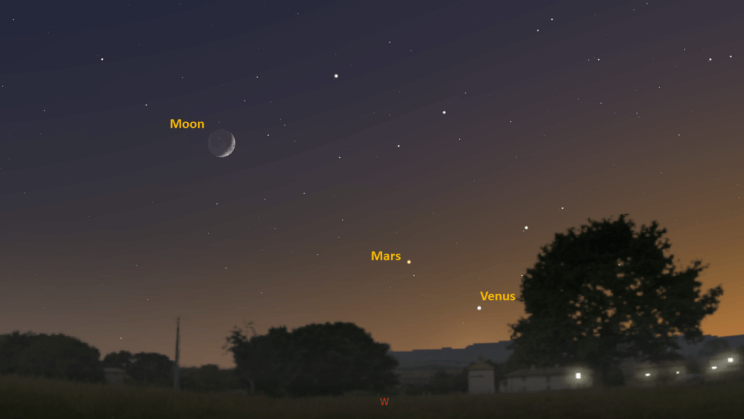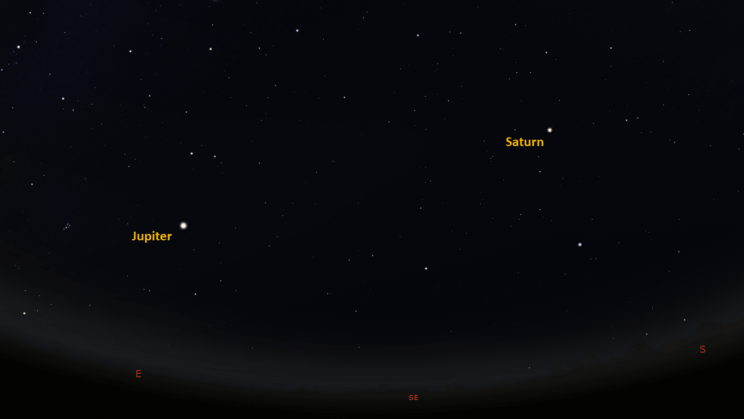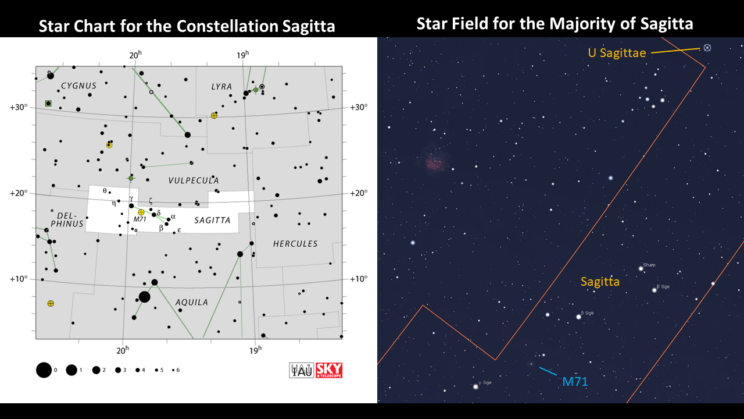This is the Saint Louis Science Center’s NIGHT SKY UPDATE for the week of Saturday, July 22, 2023.
Information updated weekly or as needed.
Times given as local St. Louis time which is Central Daylight Time (CDT). For definitions of terminology used in the night sky update, click the highlighted text. If relying on times posted in Universal Time (UT), St. louis is -5 hours when CDT.
Public Telescope Viewings
As part of the Saint Louis Science Center’s First Fridays, weather permitting, the St. Louis Astronomical Society and the Science Center will set up a number of telescopes outdoors and be on-hand to answer your questions. Telescope viewing begins once it is dark. Regardless of the weather on August 4 , join us indoors in our planetarium theater for “The Sky Tonight”. Showtime is at 7 p.m. There is no First Friday event in July.
Observing Highlight of the Week
IAU map of the constellation Sagitta. Map credit: IAU. Star field image generated using Stellarium.
This week our highlight will be the constellation Sagitta the Arrow. Like Delphinus, Sagitta is small and often overlooked. While the constellation is easy to find, the targets it offers us are a little more difficult to observe.
There are several myths associated with this constellation. One of these involves the story of Hercules and Zeus’s pet eagle known as Aquilla. Aquilla was said to be the bird that would retrieve Zeus’s thunderbolts, but this story has the eagle pecking out the liver of Prometheus. Everyday, Aquilla would peck out the liver of Prometheus as a punishment for taking fire from the gods and giving it to humanity. One version of the story suggests Hercules ended his torment by defeating Aquilla. Sagitta was the arrow Hercules used to slay the giant bird.
Sagitta is found about 10° north of the bright star Altair in the constellation Aquilla. It has four bright stars that form an arrow shape halfway between the stars Altair in Aquilla and Albireo in Cygnus. These four bright stars are Gamma, Delta, Beta and Alpha Sagittae (Sge). Gamma and Beta Sge are evolved red giants, while Delta Sge is a red super giant and Alpha Sge is a yellow bright giant star. Bright giants are stars that straddle the line between giant and super giant stars.
Halfway between Gamma and Delta Sge is the star cluster Messier 71. Its apparent magnitude is currently listed as 6.1. This puts the star cluster well within the range of binoculars, but the number is a little misleading. Posted magnitude values are based on the object being a point of light like a star. Objects like M71 have a larger visual surface area meaning the brightness is spread over a greater area of the sky. This results in the object looking fainter than a star sharing the same magnitude. While it is visible through binoculars it will only appear as a dim patch of light.
M71 is a loosely packed globular star cluster that is found about 13,000 light years away. It has a classification of X-XI indicating it is loose or very loose towards its center. It has roughly 50,000 solar masses which is on the low side for globular clusters. Additionally, its age is estimated to be between 9 and 10 billion years which puts M71 on the young end of globular clusters in the Milky Way.
Beyond M71, another interesting target in Sagitta is the variable star U Sagittae. U Sagittae (U Sge) is found about 9° west of Beta and Alpha Sge. This star varies in brightness because it is an eclipsing binary system. This means there are two stars orbiting each other. From Earth we look at them along their orbital plane so the two stars will eclipse one another causing the system’s overall magnitude to briefly decrease. The binary systems’ magnitude varies from 6.4 at its brightest to 9.8 at its dimmest, on a period of roughly 3.381 days. U Sge is visible through binoculars, however, when the primary eclipse is underway, U Sge will be difficult to see so a telescope will be a better option. According to the ephemeris posted by the AAVSO, the next primary eclipse for the U Sge system occurs on July 29-30 with greatest eclipse occurring around 2:00 a.m. UT. If you plan to observe the minima of U Sge on July 29, 2023, keep in mind it will be at greatest eclipse during twilight in St. Louis. We will experience the star coming out of its minima period instead of entering it.
The Sun and Moon

The Moon as seen from the International Space Station, on July 31, 2011.
Credit: NASA
Sunrise is at 5:54 a.m. on Friday, July 22 and sunset is at 8:20 p.m. providing us with roughly 14.5 hours of daylight. Even after sunset, light from the Sun will dimly illuminate our sky for a little less than 2 hours. This period is called twilight, which ends around 10:10 p.m. this week. For those with a sundial, local noon occurs around 1:07 p.m. this week.
| Day | Sunrise | Sunset | ||||||||||
|---|---|---|---|---|---|---|---|---|---|---|---|---|
| 22-Jul | 5:54 a.m. | 8:20 p.m. | ||||||||||
| 23-Jul | 5:55 a.m. | 8:19 p.m. | ||||||||||
| 24-Jul | 5:55 a.m. | 8:19 p.m. | ||||||||||
| 25-Jul | 5:56 a.m. | 8:18 p.m. | ||||||||||
| 26-Jul | 5:57 a.m. | 8:17 p.m. | ||||||||||
| 27-Jul | 5:58 a.m. | 8:16 p.m. | ||||||||||
| 28-Jul | 5:59 a.m. | 8:15 p.m. | ||||||||||
| 29-Jul | 6:00 a.m. | 8:14 p.m. | ||||||||||
| 30-Jul | 6:00 a.m. | 8:13 p.m. |
Moon
Moonrise for Saturday, July 22 was at 10:21 a.m. and moonset occurs at 11:07 p.m. On Saturday, July 22, the Moon will exhibit a waxing crescent phase with 23% disk illumination. First quarter moon occurs on July 25, 2023, at 5:07 p.m.
International Space Station (ISS) Observing

There are several visible passes of ISS from St. Louis for the week of July 22. They occur during evening hours. The best passes for this week are listed below. Use the table below for information about these passes.
Catch ISS from St. Louis starting Saturday, July 22
| Date | Starts | Max. altitude | Ends | |||||||
|---|---|---|---|---|---|---|---|---|---|---|
| Time | Alt. | Az. | Time | Alt. | Az. | Time | Alt. | Az. | ||
| 27 Jul | -3.5 | 22:24:50 | 10 | NW | 22:27:49 | 68 | WNW | 22:27:49 | 68 | WNW |
| 28 Jul | -3.3 | 21:36:26 | 10 | NW | 21:39:43 | 53 | NE | 21:41:08 | 29 | E |
| 30 Jul | -3.2 | 21:36:10 | 10 | WNW | 21:39:25 | 48 | SW | 21:40:45 | 29 | SSE |
Magnitude (Mag): The Measure of brightness for a celestial object. The lower the value is, the brighter the object will be.
Altitude (Alt): The angle of a celestial object measured upwards from the observer’s horizon.
Azimuth (Az): The direction of a celestial object, measured clockwise from an observer’s location with north being 0°, east being 90°, south being 180° and west being 270°.
For information about ISS flyovers and other visible satellites, visit www.heavens-above.com
Detailed information regarding all unmanned exploration of our universe, missions past, present, and planned, can be found at Jet Propulsion Laboratories:
The Visible Planets

Looking west at 9:00 p.m. on July 22, 2023. Credit: Stellarium, EG

Looking Southeast at 3:00 a.m. on July 23, 2023. Credit: Stellarium, EG
This week, four naked eye planets will be visible. Venus and Mars are found in the west after sunset. Saturn and Jupiter are visible in the south and east in the early morning.
Venus
The window to observe Venus is closing. Venus now sets around 9:24 p.m. Venus reaches inferior conjunction on August 13, 2023. Evening views of the planet will end as we reach August 1, 2023. Enjoy Venus while you can before it becomes a morning target later this year.
Mars
Mars now rises before sunset, becoming visible once it is dark. Look for it in the west about 30 minutes after sunset. Mars sets at 10:08 p.m.
Jupiter
Jupiter rises at 12:52 a.m. About one hour after Jupiter rises, it should be easy to spot. Jupiter will rise about 20 minutes earlier each week.
Saturn
Saturn rises at 10:07 p.m. Start looking for Saturn about 30 minutes after it rises. If you have lots of trees or buildings, you may have to wait an hour or so after it rises before it will be visible.
James S. McDonnell Planetarium
Night Sky Update: July 22-30, 2023







